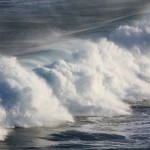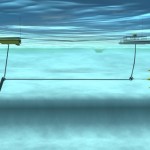We have much more to do and your continued support is needed now more than ever.
Turning Tides: Generating Energy from the Sea
September 15, 2009

“This source of energy is completely new to the United States, in terms of trying to harness energy from tides, currents, waves and offshore winds,” says Maggie Merrill, coordinator for the New England Marine Renewable Energy Consortium (MREC), which is housed on the University of Massachusetts-Dartmouth campus.
This summer, MREC received a $950,000 federal grant to study the potential for tidal-energy projects, including a specific project in the nearby Muskeget Channel between Martha’s Vineyard and Nantucket, which could potentially generate enough energy to power those islands. MREC includes working partnerships with many regional universities, such as the University of Massachusetts-Amherst, University of Rhode Island, University of New Hampshire and MIT.
According to a study by the non-profit group, Electric Power Research Institute (EPRI), the current peak demand for energy in the New England area is estimated at 28 Gigawatts. EPRI also estimates that New England’s adjacent waters could yield over 200 Gigawatts in electricity by utilizing hydrokinetic technologies.
“There’s precious few people actually doing this [work],” says Merrill. “And why university people are involved in it is because they have extensive backgrounds in oceanography, hydrodynamics and understanding the sea floor. With this grant, we’re working to build a center that brings people together to get their thoughts and ideas and their technologies in the water or near the water.”
Another non-profit organization, the Union of Concerned Scientists, suggests that the amount of energy that could feasibly be captured from U.S. waves, tides and river currents, entirely from current project proposals, is enough to power over 67 million homes. This level of development would be the equivalent of displacing 22 coal-fired power plants and avoiding the annual emission of nearly 86 million metric tons of carbon dioxide.
“It’s going to be a few years before this industry is commercially viable,” says John Miller, MREC’s Director. “This industry is like wind was five or ten years ago.”

Knowing which technologies work best in an environment is all part of the extensive research process still being conducted.
“There’s an interesting trade-off,” explains Miller. “We don’t have as much tidal power, but it tends to be close to shore and it’s extremely predictable. Wave energy is the one that has the highest utilization, whereby if you can generate at all, it has the greatest percentage of time that you’re actually generating, but it tends to be further from shore and the predictability’s on the order of a day or so. Wind has the greatest resource, but is the furthest from shore and its predictability is on the order of hours.”
“This work is really about location, location, location,” adds Maggie Merrill.
If location is key, then Florida Atlantic University (FAU) may have an edge in this field. With over 8,400 miles of coastline, Florida is second only to Alaska for miles of saltwater shoreline in the United States. Coupled with lots of coastline, Florida also sits next to the Gulf Stream, a 62-mile-wide current that runs as deep as 3,900 feet and travels approximately 5.6 mph.
“At FAU, we are looking almost exclusively at using the Gulf Stream as a source of power,” says Dr. Howard Hanson, Scientific Director of FAU’s Center for Ocean Energy Technology. “It turns out to be a great test-case for the concept that you can use a large ocean current to generate power, and it’s within 20 miles of the seventh-largest metropolitan area in the country, with a relatively large base-load energy demand, especially in the summer when we turn our air conditioners on.”
“I think I can say with some degree of confidence,” explains Hanson, “that we should be able to get enough power from the Gulf Stream to replace maybe two medium-sized power plants,” which produces about two million kilowatts of power, enough for roughly 100,000 homes.
The Union of Concerned Scientists, on the other hand, believes that capturing only 0.1 percent of the available energy in the Gulf Stream could supply Florida with 35 percent of the state’s electricity needs.
This is not the first time, however, that Florida has been the center of hydrokinetic attention. During the 1973 oil crisis and the OPEC embargo that followed, a meeting convened in Florida of the world’s leading oceanographers who looked specifically at generating power from the Gulf Stream. The scientists published a report that indicated it was indeed possible to harness power from the Gulf Stream and that there was an intention to move ahead with the project.
“Of course,” explains Hanson, “the embargo ended, the price of oil went back down and everyone forgot about [the report]. This was also before the days of any real evidence of global warming. Going back to cheap oil was the solution.”
Interestingly, in the last 30 years the oil and gas companies have developed many advanced technologies for working offshore, and it is these advances that are helping Dr. Hanson and FAU move forward with their projects today in the Gulf Stream.

“What we’re trying to do is put the infrastructure in place to get the industry moving,” says Hanson. “There’s nothing like that for the ocean turbine industry and we’re trying to put one together where companies can come and work with us on testing their turbines in the real world, so to speak.”
To bolster “real world” experiments on the Pacific coast, last year the Department of Energy awarded a five-year, $13.5 million grant to the Northwest National Marine Renewable Energy Center (NNMREC), which is a partnership between Oregon State University (OSU) and the University of Washington (UW).
OSU will serve as the lead institution and lead the charge on testing and developing coastal wave energy. UW will focus on tidal energy in estuaries and free-flow turbine applications, and more specifically, UW will be working to generate energy from Puget Sound.
Researchers at UW estimate that the Puget Sound can conservatively generate 100-200 megawatts of energy, which is about 10-15 percent of Seattle’s base-load energy requirements (1,200 megawatts). By UW’s side is the Public Utility District of Snohomish County No. 1, the second-largest publicly-owned utility in the Northwest and twelfth largest in the country. Snohomish PUD’s service territory adds 8,000-10,000 new connections every year, increasing its annual energy load by 15-20 megawatts.
Currently, UW researchers are looking for “sweet spots” in Admiralty Inlet where Snohomish PUD can implement its pilot project, placing three turbines on the sea floor over the next two years with the expectation to generate about one megawatt of electricity.
At least one non-profit group in the Northwest has shown concern about the possible environmental impacts tidal turbines could cause in the region. In 2006, the Friends of the San Juans filed to be part of the federal permit process for Snohomish PUD’s project because the group claimed the project “will potentially impair our restoration and conservation efforts in the waters, tidelands, and beaches of San Juan County” and the real impacts of such a project on marine life are simply “unknown.”
“For us,” explains Stephanie Buffum, executive director of Friends of the San Juans, “the primary concern is that they’re placing these [turbines] in primary orca habitat, a federally-listed endangered species for which we co-petitioned back in 2001. We want to make sure there’s a federal nexus happening here.”
“Snohomish PUD is still in their fact-finding phase,” says Buffum, “so they really haven’t moved forward very far except for their testing to see what sorts of technologies would fit best in a marine environment. This is such a new arena, and when you’re talking oceans you’re talking [bio-]fouling. You’re talking a lot of expenses and maintenance.”
Many Washington utility companies are exploring renewable energies since the state passed Initiative 937 in 2006, requiring that by 2020, at least 15 percent of the state’s electricity be produced from renewable resources, which includes tides and waves.
As the hydrokinetic industry develops in the coming years, more partnerships will surely be formed, and universities like UMass-Dartmouth, Florida Atlantic University, OSU and UW will be ready and waiting to offer their knowledge to developers and investors. And if there are three things that these schools can offer in addition to their knowledge, it’s location, location, location.




















